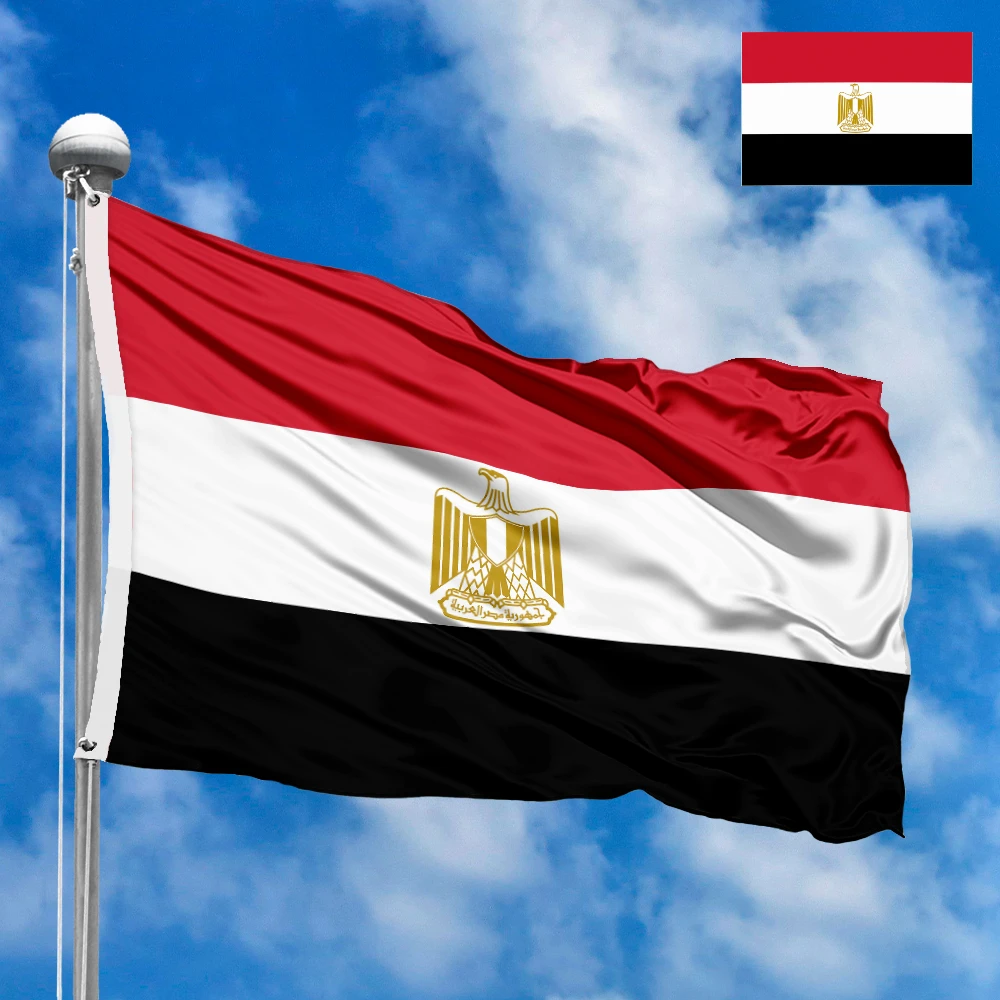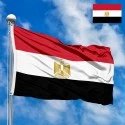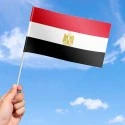The national flag of Egypt is a powerful and evocative symbol that embodies the nation's rich history, its revolutionary spirit, and its enduring aspirations for unity, freedom, and justice. Adopted on October 4, 1984, the current design reflects a culmination of centuries of cultural evolution and a modern reinterpretation of deep-rooted historical narratives. More than just a national emblem, the flag serves as a profound representation of Egyptian identity, heritage, and the collective memory of its people, echoing their struggles and triumphs throughout the ages.
Design and Symbolism: A Palette of Egyptian History and Aspirations
The flag of Egypt is a horizontal tricolor, featuring three equal stripes of red, white, and black, with the national emblem – the golden Eagle of Saladin – centrally placed on the white stripe. Each color and the emblem itself carry significant historical and cultural weight:
-
Red Stripe: The uppermost red stripe symbolizes sacrifice, the revolutionary spirit, and the blood shed by Egyptians for their freedom and independence. This color speaks to the nation's long history of struggle against various forms of oppression and foreign occupation, from the Mamluk and Ottoman empires to British colonialism. It represents the courage, strength, and unwavering determination of the Egyptian people in their pursuit of sovereignty and dignity. It's a vibrant reminder of the sacrifices that paved the way for modern Egypt.
-
White Stripe: The middle white stripe signifies purity, peace, and the bright future of Egypt. This color embodies the peaceful nature of the 1952 Revolution, which led to the overthrow of the monarchy without bloodshed, and the subsequent efforts towards national development and prosperity. It represents optimism, hope, and the aspiration for a just and equitable society where all citizens can thrive in harmony. It is also seen as a representation of peace, prosperity and optimism for Egypt's future.
-
Black Stripe: The lowermost black stripe represents the dark and oppressive periods of foreign rule, particularly under British colonialism and other forms of subjugation. It serves as a stark reminder of the times when Egypt endured tyranny and exploitation. This color symbolizes the end of oppression and the dawn of a new era of freedom and self-determination following the revolution. It’s a powerful acknowledgment of the past hardships that the nation has overcome.
-
Golden Eagle of Saladin: Centered on the white stripe is the Golden Eagle of Saladin (also known as the Egyptian Eagle), looking towards the hoist (left). This iconic emblem is a powerful symbol of strength, sovereignty, and the rich history of the Ayyubid Dynasty, founded by Saladin in the 12th century. Saladin is revered as a national hero for his role in defending Egypt and leading the Muslim forces against the Crusaders. The eagle embodies power, courage, and the nation's historical triumphs.
-
Scroll with National Name: Beneath the eagle's feet, there is a scroll bearing the name of the country, "جمهورية مصر العربية" (Jumhūriyyat Miṣr al-ʿArabiyyah), meaning "Arab Republic of Egypt," written in Kufic script. This firmly anchors the flag to the modern Egyptian state and its Arab identity.
-
Golden Color: The golden color of the eagle represents prosperity, glory, and the golden age of Islamic civilization, to which Egypt contributed significantly.
The tricolor design, with its powerful symbolism, aligns Egypt with many other Arab nations that adopted similar Pan-Arab colors following their independence movements, expressing unity and shared aspirations.
Dimensions and Proportions:
The official proportions of the Flag of Egypt are a width-to-length ratio of 2:3. This is a common and internationally recognized ratio for national flags, ensuring visual balance and aesthetic appeal. Each of the three horizontal stripes (red, white, and black) occupies exactly one-third of the flag's vertical dimension. The golden Eagle of Saladin is centrally placed on the white stripe, occupying a significant portion of its height, designed to be clearly visible and prominent without overwhelming the stripes. Precise regulations dictate the exact size and placement of the eagle to maintain consistency in official flag production.
History and Evolution: A Tapestry of Dynasties and Revolutions
The history of the Egyptian flag is a fascinating chronicle of the nation's complex political landscape, marked by foreign occupations, monarchical rule, and revolutionary transformations. The current flag is the culmination of numerous changes over centuries, each reflecting the prevailing political and social order.
-
Ottoman and Muhammad Ali Dynasty Flags (Pre-1882): For centuries, Egypt was part of the Ottoman Empire, and various Ottoman flags were used, often incorporating the crescent and star. With the rise of Muhammad Ali Pasha in the early 19th century, Egypt gained increasing autonomy, and its flags began to evolve. Muhammad Ali adopted a red flag with three white crescent moons and three white stars, symbolizing his authority over Egypt, Sudan, and Hejaz, and perhaps his allegiance to the Ottoman Empire (which also used crescent and star).
-
Khedivate and Sultanate of Egypt (1882-1952): During the British occupation (from 1882), the Egyptian flag remained largely the red flag with crescent and stars, though its status varied. When Egypt became a Sultanate (1914-1922) and then a Kingdom (1922-1952) under British influence, the flag continued to be a red field with a white crescent and three white stars. These stars were sometimes said to represent the three main religious communities of Egypt: Muslims, Christians, and Jews, or the three geographical regions. This period was marked by growing nationalist sentiments and demands for full independence.
-
The 1952 Revolution and the First Republican Flag (1953-1958): The Egyptian Revolution of 1952, led by the Free Officers Movement, overthrew the monarchy and established a republic. This pivotal event ushered in a new era and a new flag. The new flag, adopted in 1953, was the current red, white, and black tricolor, but with the emblem of the Eagle of Saladin on the white stripe, specifically a variant known as the "Eagle of Revolution." This tricolor was deliberately chosen to signify the revolution's ideals: red for sacrifice, white for purity and peace, and black for the end of oppression. It was a conscious break from the monarchical past.
-
United Arab Republic (1958-1961) and Arab Republics (1961-1972): In 1958, Egypt (under Gamal Abdel Nasser) and Syria formed the United Arab Republic (UAR). A new flag was adopted, retaining the red, white, and black tricolor but with two green stars on the white stripe, symbolizing Egypt and Syria. Even after the UAR dissolved in 1961, Egypt continued to use this flag, now referring to itself as the Arab Republic of Egypt, and keeping the two stars to represent its commitment to Arab unity.
-
Federation of Arab Republics (1972-1984): In 1972, Egypt, Syria, and Libya formed the Federation of Arab Republics. This necessitated another flag change. The flag remained a red, white, and black tricolor, but the Eagle of Saladin was replaced by the Hawk of Quraish, a different golden eagle symbol, looking towards the hoist, with a scroll beneath it. This emblem was common among Arab states.
-
Current Flag (1984-Present): In 1984, Egypt returned to a modified version of its 1953 flag. The tricolor remained, but the Hawk of Quraish was replaced once again by the Golden Eagle of Saladin, which was subtly redesigned to appear more modern and powerful, and with the country's name on a scroll beneath it. This return to the original Eagle of Saladin, a symbol more deeply associated with Egyptian history and Nasser's legacy, reinforced the nation's unique identity while retaining its Pan-Arab colors. This flag has remained unchanged since, symbolizing continuity and stability.
The evolution of the Egyptian flag thus reflects a dynamic national identity, moving between specific Egyptian symbols and broader Pan-Arab aspirations, ultimately returning to a symbol that resonates profoundly with its own historical narrative.
Regional Context and Middle Eastern/Arab Identity:
The Egyptian flag's design and colors are deeply intertwined with the broader history and political movements of the Middle East and the Arab world. The red, white, and black tricolor are known as the Pan-Arab Colors, derived from the Arab Revolt flag (1916-1918) against Ottoman rule. These colors represent the shared ideals of Arab nationalism, unity, and liberation from foreign domination. Many Arab nations, including Syria, Iraq, Yemen, and Sudan, adopted variations of this tricolor after gaining independence or undergoing significant political shifts.
Egypt's flag, therefore, positions the nation firmly within the Arab sphere. The use of the Eagle of Saladin further emphasizes this connection, as Saladin himself was a unifying figure across the Arab world. However, while sharing the Pan-Arab colors, Egypt’s unique use of the Saladin Eagle rather than, for example, the Hawk of Quraish (used by Syria and Libya during the Federation period) or stars (like Iraq or Syria), gives its flag a distinct Egyptian character. This allows Egypt to express both its commitment to Arab unity and its strong, ancient national identity. The flag serves as a visual link to the shared struggles and aspirations of the Arab nation, while simultaneously celebrating Egypt's individual historical achievements and cultural distinctiveness. It signifies Egypt's leading role and historical influence within the Arab League and the wider region, asserting its position as a cultural and political powerhouse.
Interesting Facts:
-
Pan-Arab Colors: The red, white, and black stripes are universally recognized as Pan-Arab colors, reflecting a shared heritage and aspiration for unity among Arab nations. Egypt was among the first Arab nations to adopt this specific tricolor.
-
Symbolic Evolution: The eagle/hawk emblem on the white stripe has changed three times (Eagle of Revolution, Two Stars, Hawk of Quraish, then back to the refined Eagle of Saladin), making the Egyptian flag's central emblem one of the most historically dynamic among national flags.
-
Saladin's Legacy: The choice of the Eagle of Saladin is particularly significant. Saladin was a Kurdish Muslim leader who played a pivotal role in the Crusades, revered across the Arab and Islamic world. His symbol represents strength, victory, and defense of the Arab-Islamic lands.
-
Kufic Script: The use of Kufic script for the country's name on the scroll beneath the eagle is a nod to classical Arabic calligraphy, adding an element of historical and artistic depth.
-
Revolutionary Origins: The current tricolor design was first adopted after the 1952 Revolution, signaling a definitive break from the monarchical era and emphasizing the new republican ideals.
-
No Religious Symbols: Unlike some other flags in the region, the Egyptian flag does not explicitly feature common Islamic symbols like the crescent moon and star, though its colors are deeply symbolic within an Islamic and Arab context. The crescent and stars were removed with the abolition of the monarchy.
-
Influential Design: Egypt's flag design, particularly the use of the Pan-Arab colors, has influenced the flags of many other Arab states as they gained independence or underwent political transitions.
-
Horizontal Orientation: The horizontal orientation of the stripes is common for national flags, but the central emblem gives it a unique focal point.
-
Precise Adoption Date: The current flag's precise adoption date of October 4, 1984, reflects a specific moment of national reassertion and consolidation of identity after earlier periods of broader Arab unity experiments.
-
Symbol of Continuity and Change: The flag, through its various iterations, tells a story of both continuity with deep historical roots and adaptability to major political changes.
Significance for the Inhabitants: A Banner of Identity, Pride, and Resilience
For the people of Egypt, their national flag is an immensely powerful and deeply revered symbol that resonates with centuries of history, profound struggles, and enduring hopes for the future. It is not merely a piece of cloth; it is a vivid narrative woven into the fabric of their identity, evoking collective memory and national pride.
The three horizontal stripes immediately communicate a profound historical message. The bold red at the top speaks volumes about the immense sacrifices made by countless generations of Egyptians. It evokes the memory of the blood spilled in their long and arduous quest for freedom and independence, from ancient rebellions against foreign invaders to the more recent struggles against colonial rule. This color is a constant reminder of the revolutionary spirit that has defined much of Egypt's modern history, inspiring courage and resilience in the face of adversity. It signifies the fiery passion of a people determined to shape their own destiny.
The pristine white stripe in the middle represents an aspiration for peace and the purity of their intentions as a nation. It embodies the hope for a bright, prosperous future, free from the burdens of the past. This color also serves as a poignant reminder of the relatively peaceful nature of the 1952 Revolution, which brought an end to the monarchy with minimal bloodshed. For Egyptians, it signifies the dawn of a new era of national self-determination, progress, and social justice, where peace is both a goal and a pathway.
The solemn black stripe at the bottom acts as a powerful testament to the dark periods of foreign oppression and colonial subjugation that Egypt endured. It acknowledges the historical hardships, the periods of tyranny and exploitation, from which the nation has emerged. This color serves as a stark reminder of the importance of vigilance and the enduring value of hard-won freedom. It is a symbol of the end of those dark times and the triumph of the Egyptian will to rise above adversity.
Dominating the white stripe is the majestic Golden Eagle of Saladin, a figure deeply ingrained in the collective consciousness of Egyptians. Saladin, a revered Muslim leader of the 12th century, is celebrated for his strength, his defense of Islamic lands, and his role in uniting the region. For Egyptians, the eagle embodies strength, sovereignty, and the unbroken chain of their glorious past. It evokes a sense of historical continuity and reminds them of their nation's ancient heritage and its pivotal role in civilization. Its gaze to the hoist signifies a forward-looking perspective rooted in strong historical foundations, while the scroll bearing the country's name asserts their national identity within the Arab world.
When the flag is displayed during national holidays, sporting events, or moments of crisis, it unites Egyptians across diverse backgrounds. It transcends regional, religious, and political differences, serving as a unifying symbol of their shared identity and common destiny. It instills a deep sense of patriotism, reminding them of their collective journey, their sacrifices, and their ongoing pursuit of a proud and independent future. The flag is a living testament to their resilience, their pride in their heritage, and their unwavering belief in the potential of their nation to flourish and contribute to global peace and progress. It is a constant source of inspiration and a cherished embodiment of Egyptian identity.
In the demonstration images, full-size flags are shown with proportions of 2:3, and hand-held flags with proportions of 1:2.







 Waving flag
Waving flag
 Sizes:
Sizes:
 Round flag
Round flag
 Sizes:
Sizes:
 Rectangular flag 2:3
Rectangular flag 2:3
 Sizes:
Sizes: